Defence lab reveals ultimate CCTV
- Published
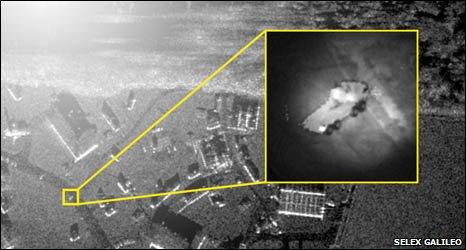
The latest defence surveillance can "pick out" potential insurgents in an image
The camera was already trained on the two insurgents before the people watching the monitors had even spotted them.
As they parked their vehicles and removed a large package from the back, it zoomed in and followed them.
The two men moved across a patch of vegetation that made them trickier to see, so the surveillance monitor automatically switched to thermal imaging and followed them closely as they tried to conceal themselves behind a building.
The suspicious pair were in fact actors. This was an experiment.
But the imaging forms part of what the UK's Defence Science and Technology Laboratory (DSTL) says will be used by soldiers within five years - a package of surveillance systems that can recognise insurgents or terrorists.
This high resolution imaging with in-built software to detect and follow the fake insurgents as they planned their covert meeting, was one of the technologies tested by DSTL during what it described as a "cops and robbers" style trial.
DSTL, which develops and tests the latest technologies for the Ministry of Defence, had members of its staff "act out" insurgent-like behaviour, while developers and engineers took on the role of the "good guys", pursuing and monitoring them.
"You can't tell who is an insurgent by what they look like, but you can track their behaviour," explained Andrew Seedhouse, chief technologist for sensors and countermeasures at Dstl.
The surveillance equipment tested in the trial ranged from extremely high resolution digital cameras to radar and lasers.
The military twist was that these hi-tech surveillance techniques are being combined with software that can pick out unusual patterns in behaviour - such as two vehicles meeting in a concealed area.
The surveillance, DSTL says, will eventually help to "win the battle" against insurgency.
Eye in the sky
The technology comes from a large collaboration of companies and academic researchers, all of which DSTL brought together in this trial.
"It's like having the ultimate CCTV system with super-sensors on the ground and flying round in the air," said Dr Seedhouse.
Most of the equipment tested on the range will take several more years to perfect and be used to monitor real insurgency in the field.
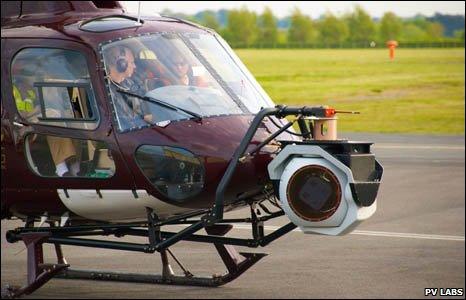
A high resolution digital camera can be mounted on the nose of a helicopter
But Dr Seedhouse said that DSTL was looking for some "quick wins" that had performed well in the trials and could be used within as little as a few weeks.
One of these could be an incredibly high-resolution camera developed by Canadian company PV Labs. Whereas most digital cameras are between eight and 15 megapixels, this camera has 128.
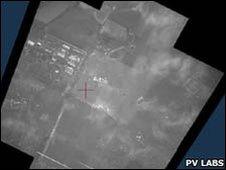
The camera captures a 4km by 4km field of view
President and CEO Ty Shattuck explained that the camera was fitted into a casement that could be mounted on the nose of a helicopter.
"It captures a 4km by 4km image. Because it's so large there's very little chance that an area of interest will disappear from your field of view," said Mr Shattuck.
"The system captures two frames per second meaning that if something happens - if a bomb goes off in a vehicle perhaps - we can rewind it and retrace where that vehicle came from"
Needle in a haystack
Some of the surveillance systems can see beyond the scope of cameras.
One technology that BAE Systems trialled, known as a "hyperspectral camera", is able to analyse colour - to distinguish a camouflaged vehicle from the vegetation it is concealed within.
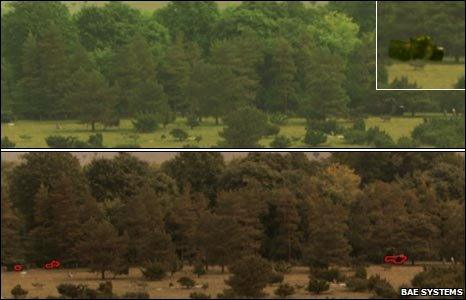
Hyperspectral imaging can pick out a green tank from green trees
Gary Bishop from BAE's Advanced Technology Centre in Bristol told BBC News: "You see things with your eyes in three wavelengths, the hyperspectral camera gives you information in 10."
The system measures each wavelength of light being reflected by an object - it can see the specific type of green that is produced by chlorophyll in plants, and distinguish that from the green of paint or dye.
"It can tell a man-made object from vegetation," said Mr Bishop. "You can think of it as looking through a haystack to see the needle."
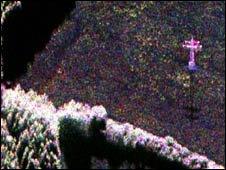
"Polarimetric" imaging interprets objects by their shape
Another approach analyses the shapes of objects to pick out potential threats.
A tiny UK technology company called Eosphere has designed a system that uses differently polarised light waves - waves travelling in different directions - to identify objects by their geometry.
The company plans to combine this approach with software that would know the shape of a potential threat. A rocket launcher, for example, is a metal tube and with a very characteristic geometry, so it would scatter light polarised in one direction more than another, and the system would highlight it.
Homing in
The detection of a potential threat is all about separating unusual from "normal" patterns of activity - spotting, for example, those two cars that appear to be heading for a covert meeting spot.
To tap in to this, developers are combining pattern recognition software with their imaging techniques to automatically "zoom in" on unusual behaviour.
Defence electronics company Selex Galileo used the DSTL trials to test a system that combines a type of radar with pattern recognition.
Iain Clark, chief engineer at the company, explained that this captured a wide view but was then able to zoom in on potential insurgents.
"So if it sees two cars parked where there isn't normally any activity, it will detect this anomalous behaviour," he said.
"And if you're still looking at [those cars] when it gets dark, you can switch to a thermal image."
Mr Clark said the system was getting "very close to being fully automated" - choosing exactly what to zoom in on, and which type of imaging would produce the clearest picture.
"At the moment we're aiming to semi-automate it, so that it separates the wheat from the chaff," he said.
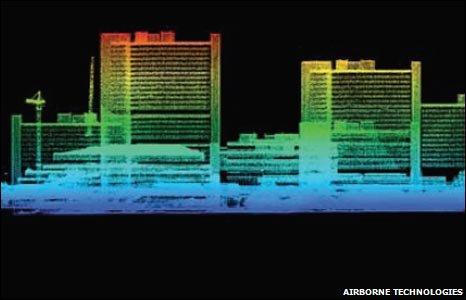
Laser imaging can be used to accurately measure the distance to targets
The same company has also developed an imaging system that can measure the exact distance and dimensions of a potential target.
"You ping a laser pulse off a target," explained Mr Clark, "and because you can control the length of the laser pulse, you can actually look at slices out in space."
BAE is working with Austrian company Airborne Technologies to tailor the equipment so it can be fitted to aircraft.
All of these systems combined, Dr Seedhouse said, use the insurgents' activities against them.
He said: "We will get to the point where we can prevent them from hiding in the background noise and where they become a target."